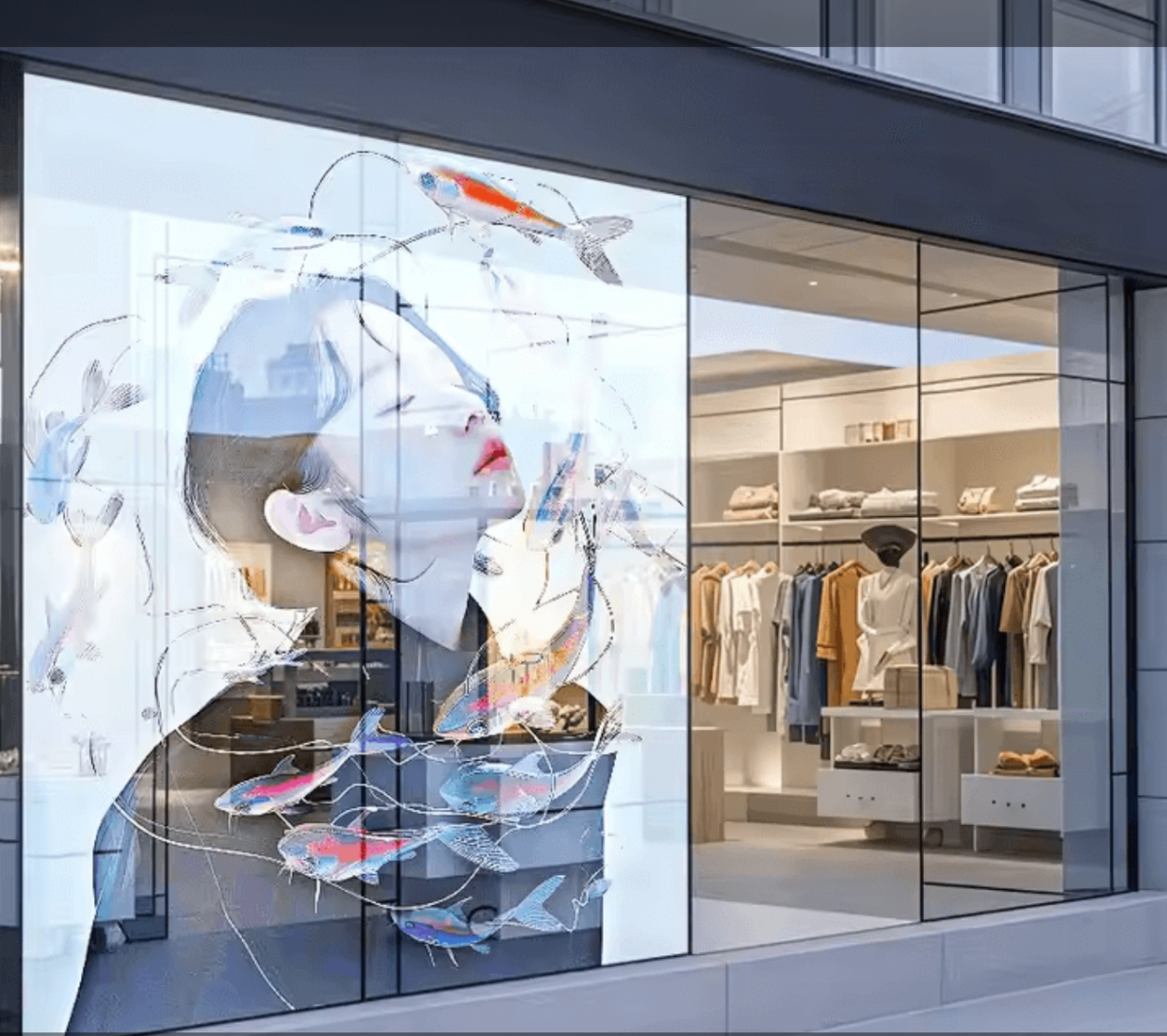
1. What Is a Transparent LED Film Display?
A transparent LED film display is a lightweight, nearly invisible layer of LEDs that adheres directly to glass surfaces. When turned off, it remains mostly transparent; when active, it displays crisp visuals that appear to float in midair. This is made possible by ultra-slim construction, high-transparency design (typically 92–98% transparency), and careful pixel layout.
Also referred to as see-through LED screens, glass LED displays, or transparent LED panels, these solutions let architects and advertisers converge form and function.
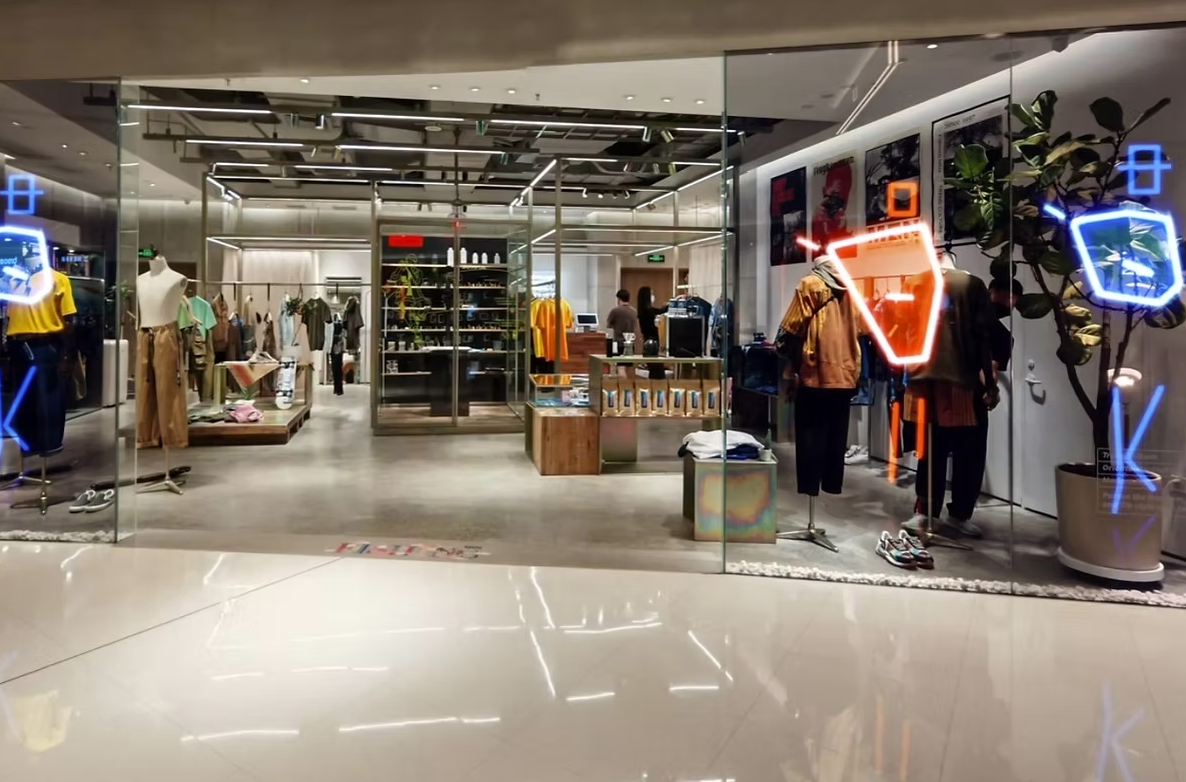
2. Why Transparent LED Displays Matter Today
The rise of transparent LED film displays is not accidental. Several market pressures and technological advances converge:
- Retail experience demands: Brands want window displays that attract and engage, not static posters.
- Architectural integration: Designers embrace systems that preserve light and view while adding digital features.
- Technological maturity: Ultra-fine-pitch films (like P2.5, P3, P4) now rival older LED cabinets in clarity.
- Cost / weight savings: Compared to framed LED walls, film display systems reduce structural cost and installation time.
Search trends reinforce this shift: “transparent LED display,” “LED film display,” and “see-through LED screen” have climbed in search volume among signage specifiers.
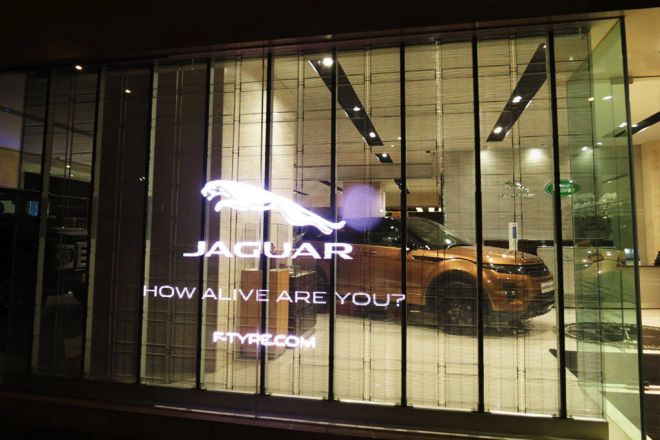
3. Product Spotlight: Leading Transparent LED Film Display Solution
For concreteness, consider a strong example from the market: a transparent adhesive LED film / glass LED display product line. This product line offers:
- Modular film sheets cut to custom sizes
- High brightness (2,000 to 6,000 nits) for daylight visibility
- High transparency (92–98%) that keeps interiors open
- Thin profile (1–3 mm) and low weight
- Modular serviceability and front access
- Flexible design for curves and irregular glass areas
This product line represents the kind of solution you could offer or develop — a blueprint for customization and marketing.
4. Step-by-Step Customization Plan
Here’s a structured plan you can follow or present clients, refined to avoid sounding formulaic. Use this in proposals, marketing materials, or project documentation.
Step 1: Site survey & requirements gathering
- Collect glass dimensions, glass type (single, double, laminated), mounting side (interior or exterior).
- Record viewing distances (where people will stand).
- Measure ambient light (lux) at different times to assess brightness needed.
- Photograph the site, take architectural drawings or elevations.
Step 2: Select pixel pitch & film variant
- Fine pitches (P2.5–P4) suit indoor or close-view use cases (museum windows, interior partitions).
- Coarser pitches (P6–P10) work well for large façades or storefronts viewed from meters away.
- Use a guideline: viewing distance (m) ~ pixel pitch (mm) × 1.8 to 2.5 (adjust for desired sharpness).
Step 3: Design mockups & client approval
- Overlay proposed content (images, animations) onto photos of the real glass surfaces.
- Provide two lighting modes (daytime & evening) so client sees dynamic performance.
- Use high-quality mockups and even AR previews if possible.
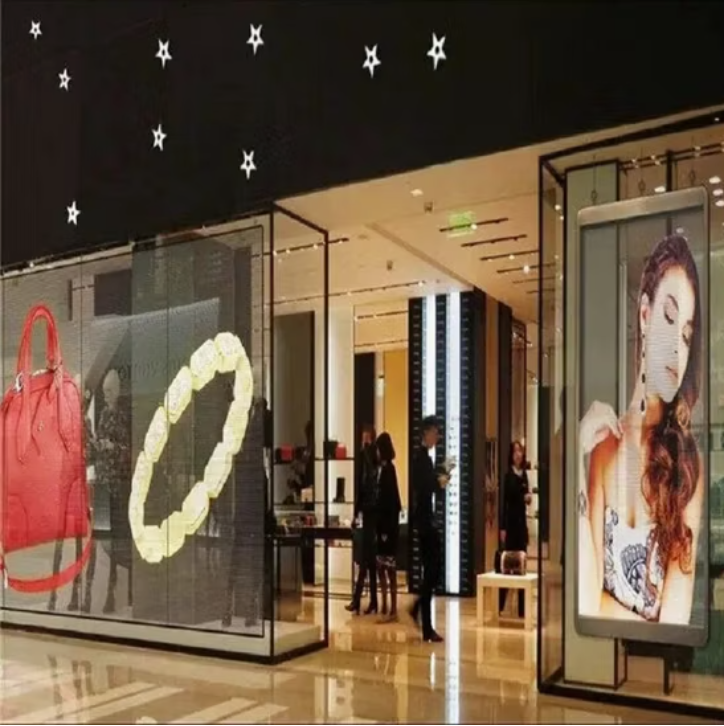
Step 4: Electrical & control design
- Plan where power and signal controllers will live (behind ceilings, in mullions, or hidden enclosures).
- Determine cable routing, power injection points, and redundancy needs.
- For large installations, plan multiple controllers and synchronization zones.
Step 5: Manufacture & quality assurance
- Fabricate film modules per the glass layout.
- Pre-test brightness uniformity and color calibration in the factory.
- Label each module for easy re-installation and service.
Step 6: Installation
- Thoroughly clean the glass (no dust, grease).
- Peel protective film and apply adhesive-based LED film carefully, avoiding bubbles.
- Align and connect modules, test wiring and signal paths.
- Power up, run color calibration, gamma correction, and brightness checks.
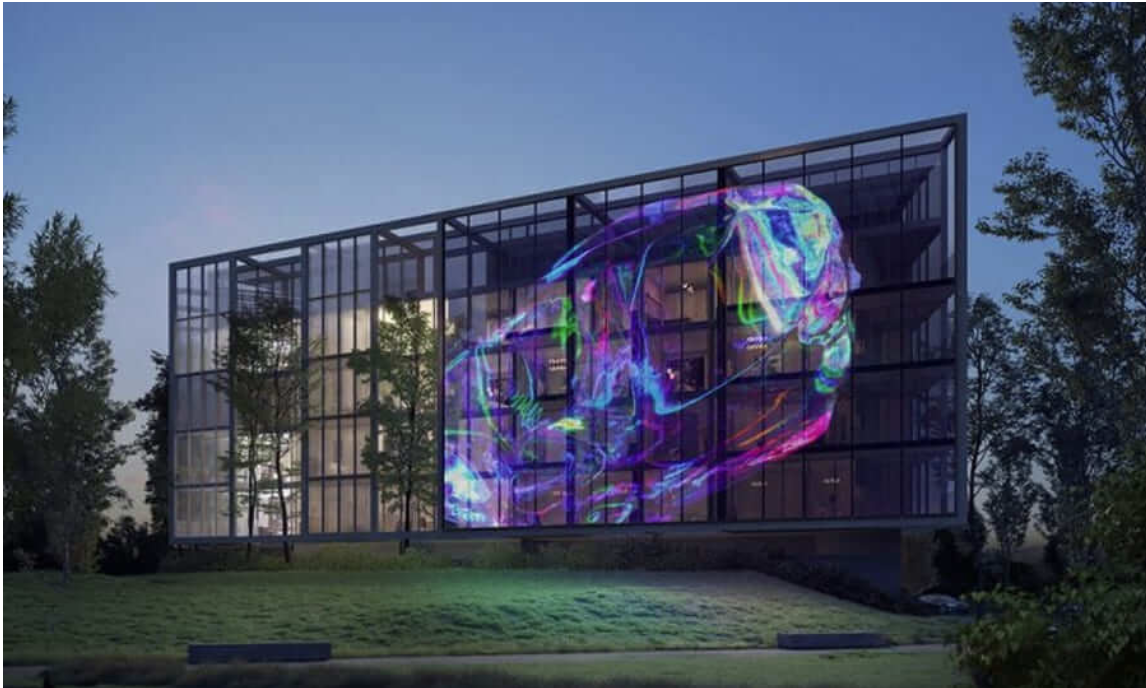
Step 7: Commissioning & training
- Run real content playback, simulate different ambient lighting scenarios.
- Train client staff on brightness control, scheduling, and CMS usage.
- Provide documentation, spare modules, and recommended maintenance intervals.
Step 8: Warranty & ongoing support
- Clearly state warranty terms (LED brightness retention, module replacement).
- Offer service-level agreements (SLA) for remote diagnostics and fast replacement.
- Propose periodic preventive maintenance.
5. Why Choose Our LED Film Solution — Key Differentiators
Below are the strong selling points you can emphasize. Use them in proposals, product pages, and marketing materials.
Technical Strengths
- High transparency (92–98%): maintain natural lighting and views.
- Ultra-thin and lightweight: minimal structural load, ideal for retrofits.
- High brightness capabilities: suitable even for sunlit façades.
- Low power draw: efficient operation, especially with smart content.
- Flexible & curved form factor: can adapt to non-flat glass surfaces.
- Modular front-access design: easy to service individual modules.
- Seamless visual effect: minimal seams, pleasing aesthetic.
Commercial & Operational Benefits
- Cost-effective installation: no heavy steel frames, faster labor.
- High ROI potential: façade used as advertising medium without blocking view.
- Scalable deployment: begin with one window, expand to full façade.
- Future-proofing: content can evolve, system can scale.
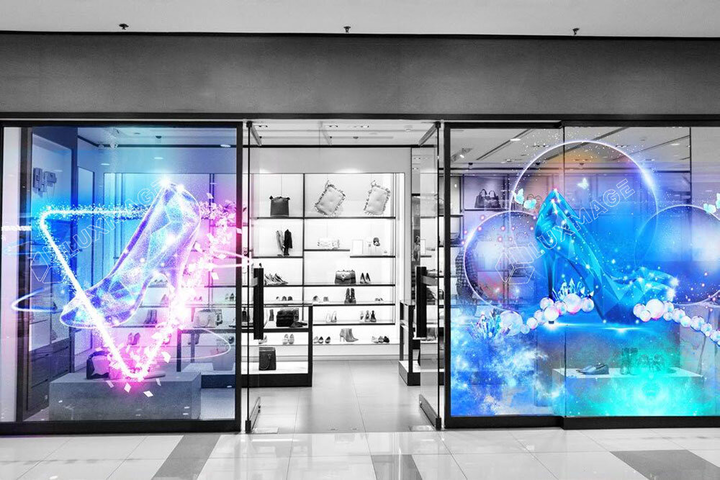
6. Technical Features & Example Specifications
Here is a sample spec set you can adapt for your product listings or proposals:
- Pixel pitch options: P4, P5, P6, P8, P10,P15, P20
- Module size: common panels (e.g. 1000 × 400 mm), customizable
- Transparency: 92–95%
- Brightness (adjustable): 2,000 – 6,000 nits
- Power consumption: average ~150–250 W/m²
- LED type: SMD (varieties depending on model)
- Viewing angle: ±160°
- Operating temperature range: –20 °C to +50 °C
- Lifetime: 50,000+ hours (to 50% brightness)
- Installation method: adhesive, optional suspension
- Control & connectivity: HDMI, DVI, LAN, Wi-Fi, CMS compatibility
- Maintenance access: front or modular swap
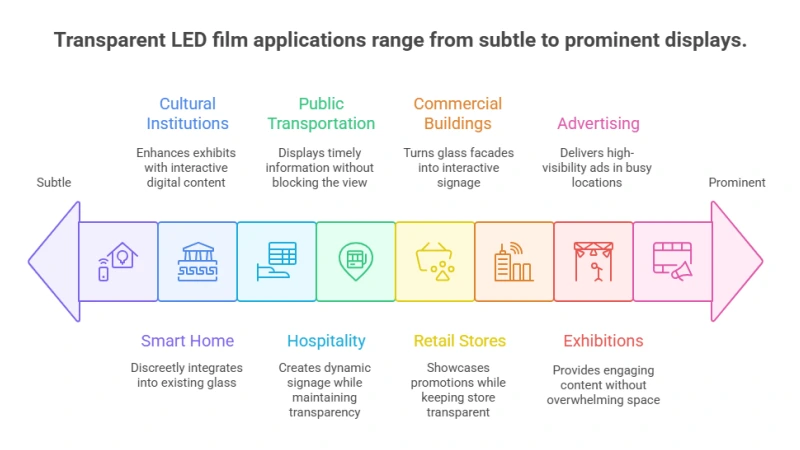
7. Use Cases & Application Showcase
Retail & Flagship Stores
Transform windows into storytelling canvases: product launches, promotions, immersive displays.
Malls & Atriums
Install across glass balustrades, atrium windows, or suspended glass walls to engage shoppers.
Museums & Galleries
Display media overlays on glass exhibits — content appears to float without blocking the artifacts.
Hotels, Restaurants & Hospitality
Lobby visuals, event messaging, or façade animations create elegance and draw attention.
Airports & Transit Hubs
Broadcast information and advertisements on large glass walls where passenger traffic is high.
Corporate & Broadcast Studios
Brand messaging on glass partitions or as dynamic backdrops for presentations and filming.
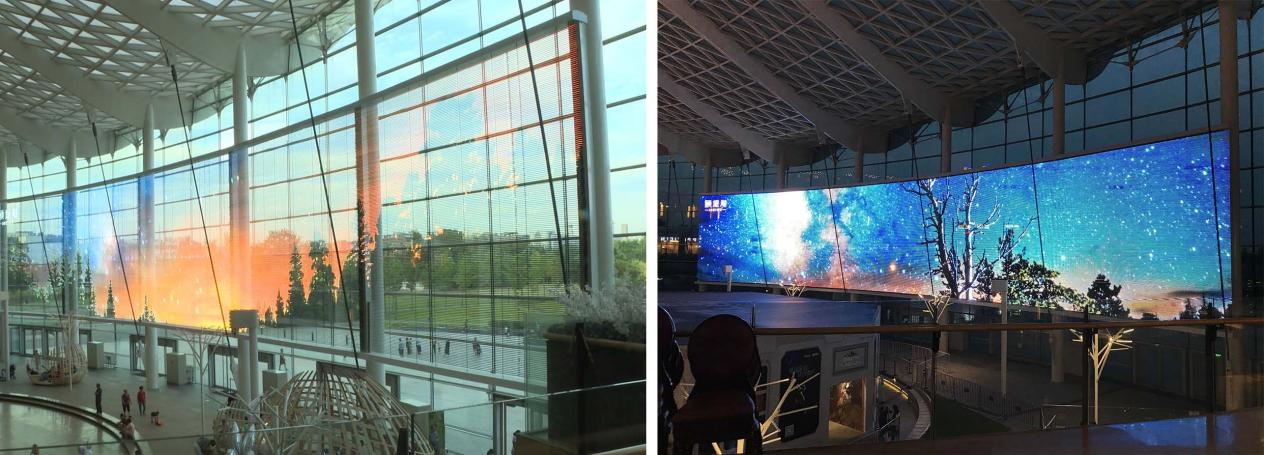
8. Installation & Maintenance Best Practices
Installation Tips
- Perform final glass cleaning right before applying the film.
- Work in controlled environments (low dust, stable humidity).
- Use squeegee tools during application to remove air pockets.
- Test modules before final sealing.
- Follow calibration routines in situ.
Routine Maintenance
- Clean gently using non-abrasive glass cleaners.
- Avoid aggressive solvents that could degrade adhesives.
- Conduct quarterly visual checks.
- Keep a stock of spare modules and connectors.
- Log brightness over time to detect degradation early.
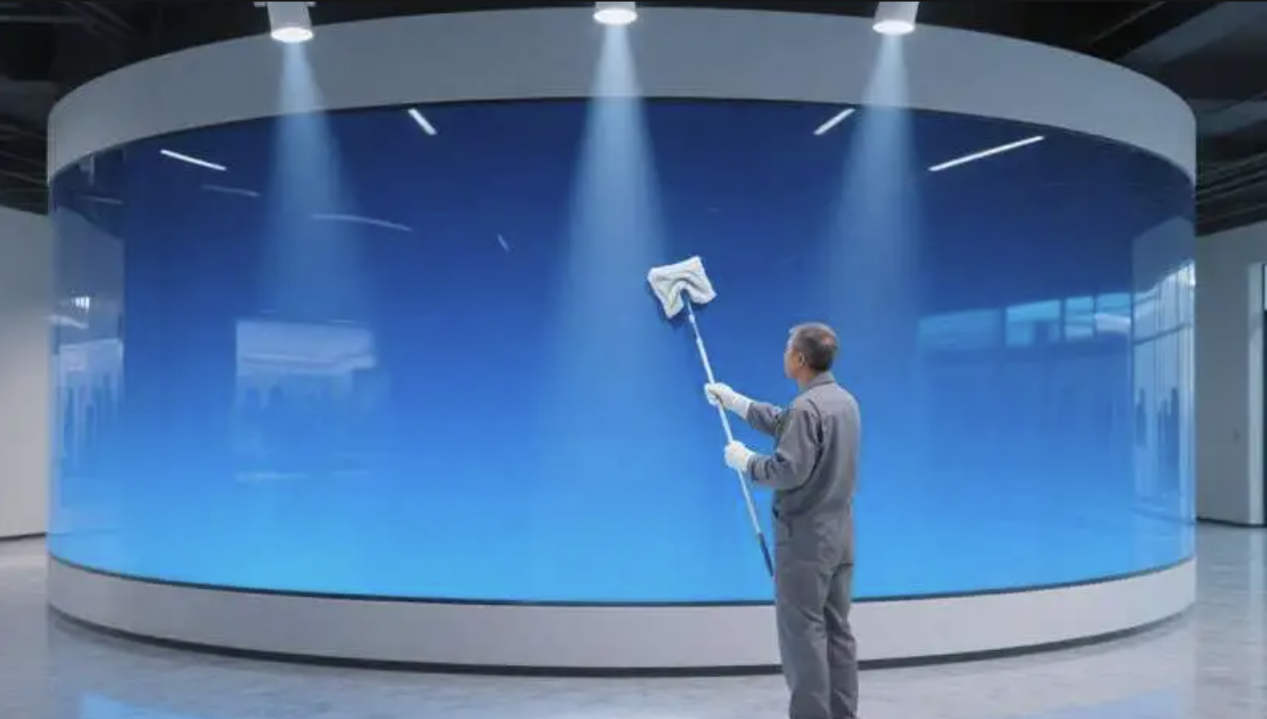
9. Content Strategy & Control System
Recommended content types: video loops (MP4, MOV), animations, high-contrast branding graphics.
Best practices:
- Use simpler, bolder visuals rather than overly detailed small text (especially on coarser pitches).
- Implement different playlists for day and night modes.
- Leverage masking or transparency effects to let ambient visuals contribute.
Control & CMS
- Choose a CMS that supports scheduling, remote control, diagnostics, brightness auto-adjust, and cloud management.
- Use controllers that support gamma correction and HDR-like color fidelity.
- In multi-site deployments, ensure your CMS allows regional or branch-level playlists.
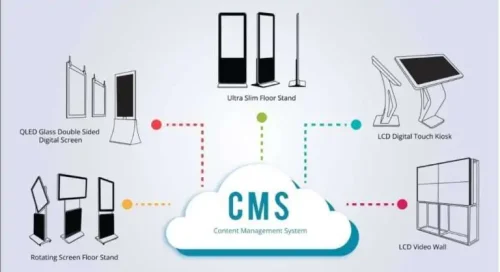
10. Pricing, Cost Drivers & ROI
Key Factors That Influence Price
- Pixel pitch (finer pitch costs more)
- Total area in square meters
- Brightness levels (higher nits = higher cost)
- Outdoor vs indoor (weatherproofing, extra sealing)
- Complexity of installation (curves, hard-to-access areas)
- Electrical and controller infrastructure
Estimating ROI
- Use ad revenue or premium window lease income
- Factor in increased foot traffic, brand presence
- Consider energy cost and lifetime (e.g. 50,000 hours)
- Presentation: Provide clients with an ROI calculator or scenario table to show payback period
11. Frequently Asked Questions (FAQ)
Q: Is the display visible under direct sunlight?
A: Yes — by selecting high-brightness LED film and optimizing content contrast, the screen remains legible.
Q: Can it be installed on curved or irregular glass?
A: In many cases, yes. The flexible nature of LED film allows mild curvature. For extreme shapes, special engineering is needed.
Q: Will removal damage the glass?
A: The adhesive is specially formulated for safe removal. Still, removal should be done with care and tested ahead.
Q: How long will it last?
A: Expect 50,000+ hours to half brightness under normal usage conditions.
Q: Is it suitable for outdoors?
A: Outdoor-rated versions include sealing, UV-resistant adhesives, and appropriate IP protection.
Q: What content formats are supported?
A: Standard video (MP4, MOV), images (PNG, JPG), and scheduled playlists via a CMS.
Q: How do I service it?
A: The modular design allows you to swap individual film modules from the front, without dismantling the entire installation.
12. How to Request a Custom Quote
To streamline quoting, ask clients to provide:
- Project location and climate
- Glass dimensions and layout
- Desired pixel pitch or viewing distance
- Indoor or outdoor usage
- Brightness expectations
- Architectural photos or CAD files
- Desired timeline
Use a project form on your website that captures these details and automatically generates a baseline estimate and next-step recommendations.
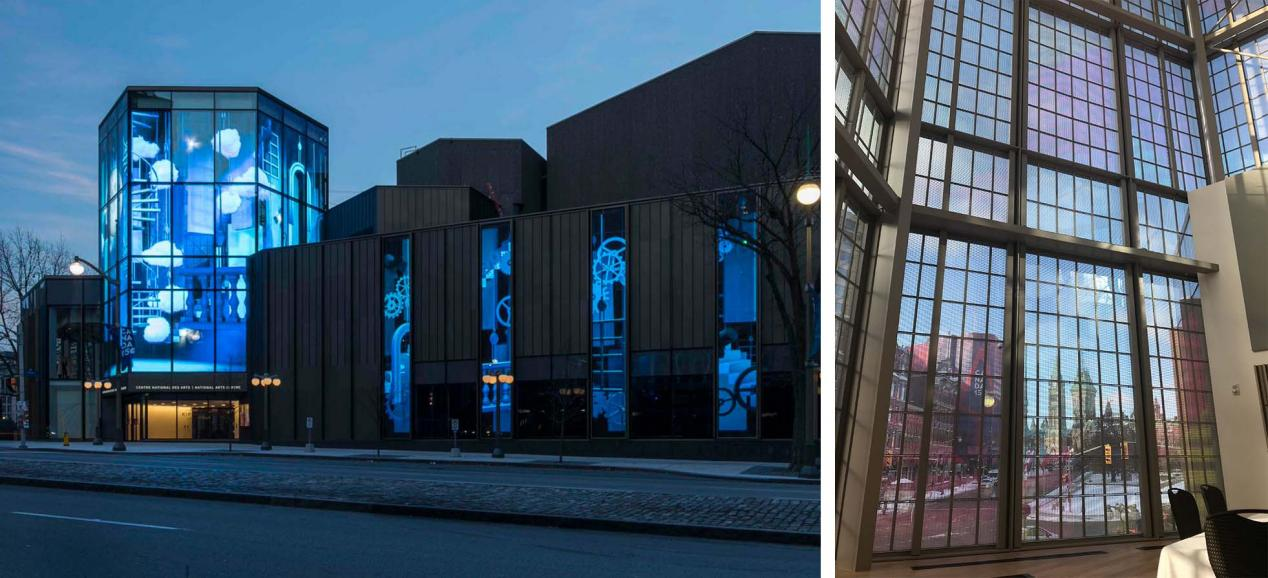
13. Summary & Closing Thoughts
Transparent LED film displays are transforming how we think about glass. They blend form and function, letting retailers, architects, and advertisers turn transparent surfaces into dynamic storytelling media. With proper customization and design, they deliver high visual impact, efficient energy use, and strong return on investment.
If your next storefront, corporate lobby, or architectural glass façade could benefit from turning into an LED canvas—now is the time to explore this cutting-edge medium.
Post time: Oct-14-2025



